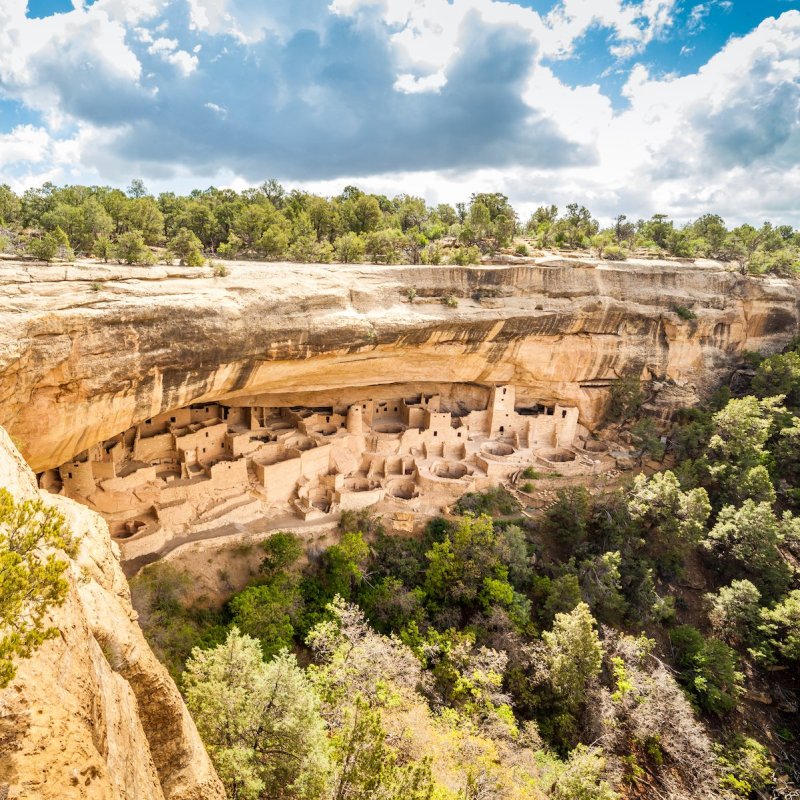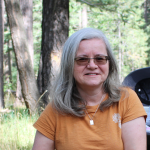
Originally established to conserve and preserve some of the most beautiful and unusual wilderness places in America, the National Park System soon grew to include archaeological and historic sites. The first park to preserve “the works of men,” as President Theodore Roosevelt put it, was Mesa Verde, established in 1906. Others followed, preserving and showcasing ancient ruins and archaeological sites throughout the country. Most of them are in the Southwest. And for good reason.
Videos by TravelAwaits
People of the Southwest built their homes and cities in stone, carving them in soft sandstone crevices or building structures up to four stories high from clay and mud bricks. In the bone-dry environment of the desert, these ancient structures baked in the sun but stayed preserved. Visible for miles in the wide-open spaces, they were easy to find, and as settlers moved into the area, they started visiting them — with no regard to their preservation. Vandalism threatened to destroy structures that stood centuries in the desert sun, and the NPS incorporated them to help preserve them.
Having lived in the Southwest for a few decades, I’ve visited these national parks, and over time a few of them became my favorites, where my family returns year after year — always finding something new. We’ve taken ranger-led tours through some and explored others on our own. The following are only a few of our favorite national parks preserving ancient ruins in the Southwest.
1. Mesa Verde National Park
Hundreds of cliff dwellings pepper the walls of the canyons and more stand-alone structures sit on the rims of Mesa Verde in Colorado, in the Four Corners area of the Southwest. The best-preserved ancient ruins in the country, some of them date from as far back as 600 A.D. They not only started the preservation of ancient monuments in the U.S. but are also a designated UNESCO World Heritage Site.
The mesa-top sites are easy to access and visit on your own. Older than the cliff dwellings, these are the sites where the Ancestral Puebloans lived before moving down into the canyon. You’ll find them at the Far View Sites Complex, the Cedar Tree Tower, and the Square Tower House and Sun Temple.
The cliff dwellings are even more spectacular, though you need to join a ranger-led tour to visit most of them. Cliff Palace is the most spectacular; others include Balcony House, Spruce Tree House, and Long House. Stop at the Visitor Center to learn more about each tour and sign up for the ones you want to join.
You can spend at least two days in the park, especially if you want to take multiple tours. Overnight lodging includes rooms at the Farview Lodge or camping at the Morefield Campground. Dining options range from the elegant Metate Room to cafes offering snacks and lunch options.
Pro Tips: The shoulder seasons offer the best experience visiting Mesa Verde; the weather is perfect and the trails and cliff dwellings are open. Summer is hot, especially mid-day, so make sure you carry water and wear sunscreen and a hat. Spend the hottest time of the day sitting at lunch in a cafe or exploring the museum. The cliff dwellings are closed during the winter, though the park remains open with opportunities for snowshoeing and exploring the mesa top.

Emese Fromm
2. Chaco Culture National Historical Park
One of the most famous archaeological sites in the Southwest, Chaco in New Mexico, in the Four Corners area of the Southwest, is also a UNESCO World Heritage Site as it preserves a major ceremonial center of the Ancestral Puebloan society.
Chaco features several large structures, or rather a system of structures called big houses. The largest and most spectacular big house is Pueblo Bonito, featuring over 600 rooms and 35 kivas. You can explore the interior of the structure, walking through the interconnected rooms. While there, look for corner windows, set up to watch astronomical events, namely the sunrise during solstices.
Other “big houses” include Hungo Pavi and Chetro Ketl. Besides these structures, Chaco features one of the largest kivas in the Southwest, the Great Kiva at Casa Rinconada, which has a diameter of 64 feet.
Since it is one of the Dark Sky Parks, besides the intensive ruins, Chaco features an observatory, the only one set up in a national park.
Pro Tips: Be prepared to drive on a dirt road to reach Chaco, which is in a remote area of the Navajo Reservation. You can reach the site from two different directions, but both roads are dirt and not recommended for RVs. The best road in our experience is the one through Crownpoint, on NM 57. Once you get to the park, you’ll be back on pavement. The park has a campground in a beautiful setting but no restaurants or snack bars, so make sure you bring enough food with you. You’ll find bathrooms at the Visitor Center but nowhere else. The closest towns with amenities are Gallup and Farmington.

Emese Fromm
3. Aztec Ruins National Monument
If you wonder why an ancient archaeological site in the Southwest is named Aztec, you are not alone. The site is a misnomer; people who built this ancient city had nothing to do with the Aztecs. They were the Ancestral Puebloans, members of the same people group that built Chaco and Mesa Verde. The ancient city is in fact considered an outlier of Chaco, and if you visit Aztec Ruins, you’ll see the same features on a smaller scale.
However, from a visitor’s perspective, Aztec Ruins National Monument in the town of Aztec, New Mexico, is much more accessible. All you have to do is drive to the end of a neighborhood street in town. Clearly marked signs point you in the right direction.
Built and inhabited between 1100 and 1300, Aztec Ruins features a “great house” you can walk through and several other structures and kivas. The highlight of the site is the only reconstructed ceremonial kiva in the Southwest.
Walking inside this kiva gives you an idea of what the originals would have looked like. Once inside, listen to a recording, adding to the ambiance. Even the Visitor Center is a museum here, set in the original house archaeologist Earl Morris, who reconstructed the kiva, lived in while he worked at the site.

Emese Fromm
4. Hovenweep National Monument
If you want to visit ancient ruins in the middle of nowhere, without driving on dirt roads, Hovenweep National Monument fits the bill. The word Hovenweep means deserted valley, and that is exactly what you find as you drive to the site on the Colorado-Utah border in the Four Corners area of the Southwest. The site is actually in both states, but you wouldn’t be able to tell which one you are in.
Hovenweep features a few tall structures along a small canyon. The largest, called Hovenweep Castle, sits on the rim, comprising a few structures. The two-mile round-trip trail leading to the ruins takes you along the rim of the canyon. Besides the castle, it passes several other structures and offers views of the Square Tower inside the canyon. The paved trail from the Visitor Center to the start of this trail is fully accessible and leads to Little Ruins Canyon Overlook. From here, you can see most of the structures.

Emese Fromm
5. Tuzigoot National Monument
Tuzigoot National Monument preserves a site on top of a hill, overlooking the Verde River, cliffs and ridges in the valley, and the Tavasci Marsh, a natural riparian area surrounding an old curve of the Verde River.
The ancient village on the hill, the Citadel, inhabited between 1100 and 1400, comprised 110 rooms by the time its builders and those who lived there abandoned the site. A paved, fully accessible trail leads to and around it, giving you a good idea of what it would have looked like. Though the views from the ruins alone are worth the walk, one room is reconstructed, and if you are there at the right time, you can enter it and see what it would have looked like when inhabited.
Pro Tip: The paved and fully accessible trail is short, but offers no shade, so make sure you have a hat, sunscreen, and water when you visit. Better yet, try to visit in the winter, when you’ll have perfect weather.

Emese Fromm
6. Wupatki National Monument
In the shadow of the Kachina Peaks (better known as the San Francisco Peaks) near Flagstaff, Arizona, Wupatki National Monument preserves several ancient ruins near the volcanic fields of Sunset Crater.
Ancient people built these structures around 1100, shortly after Sunset Crater erupted, since they found the volcanic ash made the surrounding fields more fertile. The largest structures are in Wupatki Pueblo, with access from the Visitor Center, but you’ll find other ones, Wukoki, Lomaki, Box Canyon, Nalahiku, and Citadel, within short walks from their respective parking lots.
The Visitor Center offers an excellent introduction to the area, featuring a small museum. From there, you can walk out to Wupatki Pueblo, home to the largest structure in the area, the four-story-high “Tall House,” which once featured 100 rooms. You’ll also find a large kiva and a ball court at the site. The half-mile trail takes you past these structures, though you can see them all from the overlook a few steps from the Visitor Center.
Editor’s Note: The National Park Service announced on August 18, 2022 that the Sunset Crater Volcano is partially open with limited services following the Tunnel Wildfire destruction. The Lava Flow and A’a trails are open. The Visitor Center, Lenox Crater and Lava’s Edge Trails, as well as the Cinder Hills Overlook remain closed. For the most up-to-date information, please visit NPS.gov.
Emese Fromm
7. Casa Grande National Monument
Casa Grande sits in the middle of a surrounding flat desert in Coolidge, Arizona, just a short drive from Phoenix. Part of a larger archaeological site featuring a few smaller structures and a ball court, this “big house” is part of Casa Grande Ruins National Monument. The largest known structure built by the Ancestral Sonoran Desert People, the four-story-high “house” is protected from the intense Arizona sun by a metal roof.
Built by the ancestors of the present-day O’odham people, the site was an ancient farming community, and according to the oral history of their descendants, a ceremonial center. Walk through the indoor museum to learn about the ancient people of the desert who lived here, and their ingenuity in making a life in the Sonoran Desert. Then walk through the site and experience the desert yourself.
Things To Keep In Mind When Visiting These Archaeological Sites
The ancient people of the Southwest, who built the structures mentioned above, made their home in an inhospitable environment and built civilizations here. For a long time, the view was that they mysteriously “disappeared,” leaving these elaborate structures behind.
In fact, they were all ancestors of the present-day Native tribes of the Southwest. When visiting any of the ruins, please be respectful of this. For some of us, these people’s stories may be an interesting piece of history, but for the descendants of people who built them, they are part of their cultural inheritance. By learning about their history and protecting and respecting these sites, we learn about the Native people of the area, and are richer for the experience.
